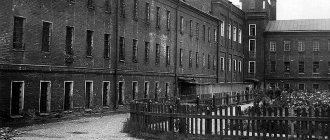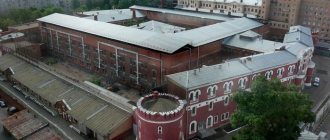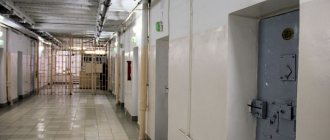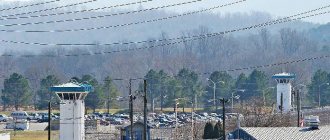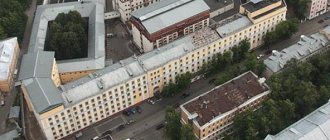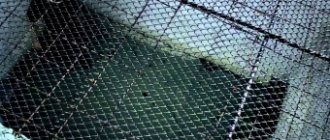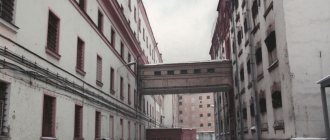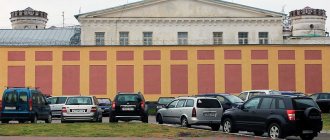What to do in Vladimir
EXCURSION “VLADIMIR CENTRAL”
- Security facility "Vladimir Central" (external inspection)
- Prince Vladimir Cemetery (with entry)
The cost of the excursion is 800 rubles/person
. The Vladimir necropolis is truly one of the most interesting places in the ancient city.
The famous Vladimir Central, glorified in the song of Mikhail Krug, is known to everyone, many want to know more about it, but getting into its territory is difficult, it is a “security facility” but the fact is that next to the ancient brick wall there is a unique unique oldest provincial necropolis , not many people know.
And this historical site has something and someone to tell about, including the famous inmates of the central prison. Prince-Vl. The cemetery (after the name of the current temple) was founded back in the 18th century, by order of Empress Catherine II. In 2010, the memorial necropolis received state protection and the status of a “cultural heritage site.”
Many famous Vladimir residents are buried here: merchants, nobles, clergy, doctors and architects. These people made up the glory of Vladimir in the 19th centuries. There are so many famous names: the Stoletov brothers (physicist and general), the hero Shipka, the surgeons Kontor and Orlov, the hero of the Sov. Union Dmitry Pogodin! The city's merchant family burial grounds (which is especially valuable, unique monuments have been preserved, constituting a valuable part of the exemplary architectural direction of the city. Even princes are buried here - Pyotr Dolgorukov and Mikhail Volkonsky (Leo Tolstoy's great-uncle). Vlad. The necropolis is poetic in its own way. Not only unique ones have been preserved tombstones, but also touching epitaphs, in which the expression of simple human feelings comes to the fore.The real pearl of the cemetery is the monument to the mother of Klim Voroshilov, modestly signed with the initials of the commander KEV.
There is also its own “wall of wailing and memory” - a memorial to foreign citizens who died in Vladimir. Polit. Prison (Japanese soldiers, an Estonian general, a German field marshal, a Lithuanian archbishop, canonized by the Holy Dormition Lavra, as well as the pride of the land, the Russian Bishop of Kovrov, the vicar of Vladimir Afanasy (Sergei Sakharov).
Many interesting unique judges, mysterious stories associated with both the residents of Vladimir and the sad inmates of the central prison can be found out on an excursion to one of the rarest provincial necropolises in Russia, the Prince Vladimir Cemetery, which miraculously survived.
“Times don’t choose; they live and die”
A legendary security facility about which songs are sung, a genuine history from its foundation to the present day, famous and especially dangerous prisoners.
Detailed information by phone: +7906-564-64-44
Source
Other places:
What is the first thing that comes to mind when you are asked about the city of Vladimir?
Numerous beautiful cathedrals and churches and, of course...
“Vladimir Central, North Wind” - the popular song of Mikhail Krug probably comes to mind. So what is the singer singing about?
About the bitter fate of prisoners or, simply, prisoners.
Because the Vladimir Central is a prison for especially dangerous criminals. Here the sentence for the most malicious violations of the law is carried out. Our casemate for prisoners was founded at the end of the 18th century by Catherine II. The oldest government house in Russia appeared on the route of hundreds of thousands exiled to Siberia. The prison was nicknamed the Central Prison already at the beginning of the 20th century for holding political prisoners.
The Prison History Museum was created in 1996. Its founder was Igor Valerievich Zakurdaev, who devoted many years to the service. The exhibits were collected with special passion and enthusiasm. The Vladimir Dungeon has preserved many stories for the modern visitor. Here you can find out how prisoners lived and live in captivity.
In order to get here you will be given a special pass and will be allowed to take only a camera with you. You will pass through several grated doors and on the way you will come across a canteen and even a bakery.
The entrance is a massive iron door, as if you are entering a real cell. How many unusual things can be discovered! Despite the prohibitions, those arrested draw playing cards. Here you can even find chess, the skillful pieces of which are presented in the form of people and sculpted from bread! From it you will see other interesting things: ashtrays, sailboats, etc.
Among other things, there is its own art gallery: portraits, landscapes and even copies of famous works by great masters - all this is the work of convicts. Among them there is even a reproduction of the famous “Bogatyrs” by Vasnetsov.
Here you will get acquainted with the fate of prisoners.
Until 1906, depending on the reason, a person who ended up here acquired a special mark. Thieves were branded “thief” on their cheeks and foreheads, and convicts were branded “kat.” Heavy and very uncomfortable shackles and chains, as well as a strict overseer, accompanied the slaves almost everywhere. After the prison reform, the Vladimir Central became a place of detention mainly for state criminals, so their situation improved slightly. And the shackles are lighter, and the chains are thinner, and the tradition of putting a brand is completely left in the past.
Vladimir Central Prison Museum
The establishment begins its history at the end of the 18th century. In 1783, by order of the Empress, a prison was created. In 1906, it received its now well-known name - Vladimir Central. During the notorious years of repression, the prison becomes a place of isolation for dangerous political criminals. In archival documents of those times it was designated as a “special purpose prison of the USSR Ministry of State Security.” And finally, in 1996, a museum was located within its walls. On Bolshaya Nizhegorodskaya there is this mute witness to the harsh realities of our lives. In our time, the prison continues to fulfill its purpose; pre-trial detention center No. 1 of Vladimir is located here.
Many famous and respectable people were kept within its walls. Among them are the revolutionary Frunze, the popular film actress Zoya Fedorova, the son of General Kutepov, the singer Lidiya Andreevna Ruslanova, the actor Alexey Yuryevich Shevkunenko... Real and imaginary spies, dangerous terrorists, saboteurs, Trotskyists and Mensheviks, Socialist-Revolutionaries and anarchists were gathered here. Many members of various anti-Soviet organizations, people suspected of dangerous anti-state connections and hostile activities visited its walls. After the war, some German military leaders were holed up in the central prison.
These days, the museum’s frequent guests are relatives of former famous prisoners. All this is reflected on museum stands, expositions, and showcases. The history of the prison, crafts and belongings of prisoners, archival documents and photographs are presented here.
Source
Golden Gate
The Golden Gate, built in 1164, was once the main entrance to the city from the west. The small structure had a whole range of functions. Firstly, the gates allowed those who came in peace into the city and were closed in front of the enemy. Secondly, there was a platform on top from which the uninvited guests were fired upon. And thirdly, the whole thing was crowned by the gate church, which blesses those entering the city. Only the gate arch remains from the 12th century building. Everything else was completed in the 18th century. The monument is open for inspection; there is a military exhibition in the gate church.
The Golden Gate is included in the UNESCO World Cultural Heritage List.
Opening hours: 10.00-18.00. Day off is Thursday, sanitary day is the last Friday of the month.
Museum "Vladimir Central": where it is located, history, description, reviews
Vladimir Central is one of the most famous prisons in Russia. Its more than two-hundred-year history hides many mysteries. In the mid-90s of the last century, a museum was opened on its territory. It is called the Vladimir Central by analogy with the name of the prison itself. In fact, this is a little different. This is a museum of the history of the Vladimir prison. This article is devoted to its basis, description and conditions for visiting.
Vladimir
sport 2 / 2
- other 0
- general tips 2
- Shopping 2 / 2
- Transport 5
- Useful 2
- Diaries 7
- Links from experienced people
- Forum Materials Wiki code directions: help Museum of the History of the Prison 115museums, exhibitions2 photodotswiki code help Wiki code of an object: write an advice Tips and reviews from travelers (1) Tell friends Did you like the tip?2 help permanent addresses wiki code help Wiki code: Select a photoAll photos in one feed2 photodots Cheap ✈ in the direction
inform the moderator
Background
State houses for keeping criminals in our country appeared 6 centuries ago. True, there were very few of them, since in pre-Petrine Russia the trial was quick, and for many, as they would say today, criminal offenses were immediately deprived of life, flogged with rods or a hand cut off. There were, of course, state criminals who, for one reason or another, were afraid to be executed, fearing popular unrest or based on some other considerations. Such persons, mainly belonging to the royal, princely and boyar families, were forced to take monastic vows and were sent to distant monasteries.
Everything changed during the reign of Catherine the Second, who, among other reforms, carried out changes in the system of punishment for crimes. In 1783, she issued a decree according to which it was prescribed that a criminal who committed petty theft should be punished with whips and placed in “workers’ houses” or, as they were also called, government houses. There they had to work until they had worked off not only the amount of damage caused to the owner of the stolen property, but also another 6 percent on top of that.
To implement the decree, it was necessary to build “workhouses” throughout the country.
Prison foundation
Immediately after becoming familiar with the decree, the Vladimir viceroyal government ordered the architect Nikolai von Berk to develop a project and draw up an estimate for the construction of a provincial “worker’s house.”
As a result, it was decided to limit ourselves to the construction of four huts with canopies and closets, as well as a square log house with a width and length of 9 arshins.
More than 145 rubles were spent on the construction of this state house from the provincial treasury, and already in August 1783 the prison was opened.
History of the prison in the first half of the 20th century
Only in 1902, the Vladimir Central, the museum at which today is considered one of the most interesting attractions of the city, became a prison in the modern sense of the word.
After the revolution of 1905, the composition of the inmates changed significantly, among whom political prisoners began to predominate. By the way, the prison began to be called the Vladimir Central precisely when those who sought to overthrow Nicholas II began to be brought there. They were kept until a party was recruited, which was sent into exile along the famous Nizhny Novgorod road.
After the Bolsheviks came to power in the country, the situation did not change. More precisely, since 1918, in the Vladimir Central prison, along with other categories of prisoners, those who disagreed with the Soviet regime began to be held.
In the mid-30s, it was transferred to the jurisdiction of the NKVD, and later became subordinate to the USSR State Security Department. In the post-war years, collaborators who collaborated with the Nazis were also kept there.
What kind of criminals end up there?
Criminals who, based on court decisions, are recognized as especially dangerous to society are sent to the modern Vladimir Central Central.
The risk of transfer to this prison arises for prisoners who violate the regime in other colonies.
No distinction is made between criminals. Convicts sentenced to different terms can be held in one cell.
The following categories of criminals are sent to prison :
- convicted repeat offenders;
- murderers with particularly serious corpus delicti;
- life-sentenced criminals;
- terrorists with various elements of crime;
- criminals recognized as serial killers or maniacs.
Modern history
In 1978, on the eve of the Olympics, documents were prepared for the transfer of especially dangerous criminals to prisons in Kazan and Chistopol. A large influx of tourists was expected in Vladimir, which is part of the Golden Ring of Russia, so it was decided to send all political prisoners as far as possible from the capital. During the same period, 26 so-called thieves in law were transferred to the Vladimir Central, the museum of which is constantly replenished with new exhibits, so the criminal situation there sharply worsened and there was a bias towards criminality.
Multi-day bus tours to Vladimir from Moscow
A bus tour to Vladimir is an unforgettable journey to the origins of the Russian state, to its ancient history, to magnificent architectural monuments included in the UNESCO list. Vladimir is the symbol of the Golden Ring of Russia and its main city. A bus tour to Vladimir from Moscow, organized by a tourist agency, gives you the opportunity to see with your own eyes the treasures of Russian antiquity, feel the breath of centuries and feel a sense of pride and love for your country.
Excursions to Vladimir from Moscow can last from two days to a week, depending on the intensity of the program. All bus tours to Vladimir, organized by our travel agency, begin at one of the metro stations (Turgenevskaya or VDNKh) with a transfer to the destination. Their route, in addition to Vladimir, includes the cities of the Golden Ring and other famous places in northeastern Russia: Suzdal, Rostov Veliky, Sergiev Posad, Pereslavl Zalessky, Yaroslavl, Kostroma, Nizhny Novgorod, Ivanovo, Bogolyubovo and others. Weekend tours to Vladimir, limited to two days, provide the opportunity to get acquainted with a relatively small part of this treasury, but will leave no less an impression.
Excursions in Vladimir include visits to the following city attractions:
- The Golden Gate is a symbol of Vladimir and the entire Golden Ring, its main attraction. A unique monument of ancient Russian white stone architecture;
- Mother of God Nativity Monastery, founded in the 12th – 13th centuries. It is called the Vladimir Kremlin. Burial place of Alexander Nevsky;
- White stone Cathedral of the Assumption of the Blessed Virgin Mary. It suffered greatly from the Mongol-Tatar invasion. The wall painting was restored in the 15th century by Andrei Rublev and Daniil Cherny. The frescoes have been preserved, and you can see with your own eyes the brilliant creations of Russian icon painters;
- Openwork Demetrius Cathedral of the early 12th century;
- A very interesting museum “Old Vladimir” with an observation deck
- and many other places in this unique city that you will see when you go on a tour to Vladimir from Moscow.
We hope that the bus tour to Vladimir from Moscow will leave you with an unforgettable impression, give you many exciting moments and strengthen your love for the fatherland.
Description of the prison
At the moment, Vladimir Central is a prison for dangerous criminals. It contains murderers, rapists, repeat offenders, etc. Among them there are also maniacs sentenced to life, who are housed in cells of two. The regime in the Vladimir Central in recent years has become more humane and closer to international standards. The cells have televisions, and some even have refrigerators. Almost any literature is available to prisoners. They are allowed to subscribe to newspapers and magazines, as well as receive parcels and see relatives.
In 1995, one of the cells of the Vladimir Central was converted into an Orthodox church, which was consecrated in the name of St. Nicholas. In 2003, a dome was erected over the church, and a few years later a small belfry was built.
In order to provide those in custody and those convicted with legal information, the first Legal Information Center in the Russian Federation was opened in 2003 at the Vladimir Central.
Schedule
Vladimir Central has fairly favorable conditions for prisoners. The repair was carried out according to European standards. Refrigerators and televisions are located in a separate chamber.
Convicts are monitored around the clock using an advanced video surveillance system.
Additionally, the prison is equipped with special sensors for unauthorized opening of doors or windows for the transfer of food.
Prisoners' daily routine:
- Convicts must wake up at 6:00 by a special sound signal (lights out at 22:00).
- On holidays, the curfew schedule may be moved to 00:00.
- Daily walks in the fresh air are carried out for one hour.
- Prisoners have the right to visit the recreation room and chapel (the recreation rooms have televisions and board games, and those who wish can use the library).
- Meals are provided three times a day.
- During the day, prisoners can work (about a fifth of prisoners use this opportunity).
- Convicts who are not involved in work are kept in their cells (except during walks).
- Prisoners who do not have a profession can take advantage of the right to vocational or secondary vocational training.
The Vladimir Central is equipped with several thousand square meters of free space. This territory is equipped for production .
Prisoners produce goods in numerous areas - food, sports equipment, plastic products, building materials and souvenirs.
, metalworking and woodworking workshops have been opened . Women are mostly involved in clothing production.
Museum "Vladimir Central": address
You can get to this establishment, the first of its kind in Russia, on foot, by walking along one of the main streets of the city - Bolshaya Nizhegorodskaya - to house No. 67. You can get there. To do this, you need to use trolleybus No. 1. Having traveled 3 stops from the station (to the “Turn to Tochmash”), you should walk along the left side of the street a little in the direction of travel. If you get lost, although this is almost impossible, you can ask any passerby about where the Vladimir Central is located.
Reception schedule for citizens and relatives
Reception of citizens by the prison management is carried out from Monday to Friday from 14:00 to 16:00 . Citizens can submit applications for visits with prisoners and arrange transfers according to a certain schedule, deviations from which are unacceptable.
Sample documents and requirements applicable for parcels are freely available on the official website of the prison.
Schedule of work with citizens:
- The room for receiving parcels and parcels is open from Tuesday to Saturday from 8:00 to 17:00 (break from 13:00 to 14:00).
- Reception of parcels and short-term visits is allowed from 10:00 to 16:00 from Tuesday to Saturday (Monday and Sunday are days off, delivery of parcels to prisoners is carried out from 16:00 to 17:00).
- The room for long-term visits operates in accordance with the application schedule (some convicts have the right to three-day visits with relatives).
- Written appeals from citizens are considered within thirty days or seven days if resolving the issue is not within the competence of the prison administration (similar rules apply to appeals in electronic form).
Where is the Black Dolphin prison located? Find out about this from our article.
Foundation of the museum
Having found out where the Vladimir Central is located, many doubt whether it is worth visiting, since not everyone wants to go to a place where they will be presented in all its glory with the features of life “according to concepts”. Those who have already visited the museum unanimously affirm that one should not be afraid of this, since it is dedicated not to the laws adopted among criminals, but to the history of the Vladimir Central Central and famous personalities who were kept within its walls over the years.
The idea of creating such an institution appeared back in the 1980s. However, during the Soviet period, its implementation was out of the question. Work on the museum exhibition began in the mid-1990s. It was attended by employees of the prison and the Vladimir-Suzdal Museum-Reserve, who enthusiastically took up the task and achieved good results.
annataliya
What do you associate with the city of Vladimir?
With beautiful ancient temples and monasteries on the banks of the Klyazma River? With historical monuments and world heritage sites?
With interesting museums, where you can learn in detail about famous people and events of the city?
That’s all true. But even if you’ve never been into chanson, it’s unlikely that you’ve never heard Mikhail Krug’s “superhit” “Vladimir Central,” and, willy-nilly, Vladimir is associated with this institution. And considering that, according to statistics, almost a quarter of the Russian population is either behind bars at the moment or has been behind bars before, the prison topic is very interesting to modern society.
And no one has canceled the proverb “out of pocket and out of prison.”
However, the Vladimir Central is also a very historical object.
He appeared back in the days
Description
The museum opened in 1997. He became one of the first in Russia. The Vladimir Central Museum occupies two former cells with blocked window openings. In the corridor through which visitors enter the museum, the best works of painting and graphics drawn by prisoners are exhibited. There are some very good works among them.
The museum itself presents many interesting documents and photographs taken in different years, personal belongings of prisoners, prison household items, etc. They reflect the history of the Vladimir Central from the end of the 18th century to the present day. The search for the exhibits took place over several years. To reconstruct the history of the prison, archives were studied, which preserved interesting information about dissidents, German high-ranking military officers, representatives of the intelligentsia, as well as the Soviet and party elite who were victims of political repression, etc.
Some exhibits came to the museum from abroad. For example, in the museum you can see a number of documents that arrived in Vladimir from the United States from relatives of the American pilot Powers, who served time in the central prison in the early 1960s.
A separate place is reserved for a collection of items created by prison craftsmen. Among them is a tattoo machine made from a razor, a charger for a mobile phone built into the sole of a slate, etc. One of the most interesting exhibits is an ancient samovar, which has been providing the “stayers” with boiling water almost since the reign of Catherine the Second.
With great interest, visitors also get acquainted with photographs taken in 1935-1940, when mostly “enemies of the people” were imprisoned, including relatives of Joseph Stalin’s wife.
Museum visitors are invited to examine the products of the workshops in which prisoners work. These are soccer balls, boxing gloves, telephones, etc.
Reviews
Prison is not a fun place, so people with weak psyches should refrain from visiting the Vladimir Central Museum. Reviews show that an inspection of the prison premises that are allowed to be visited makes a depressing impression. As for the rest, history buffs find this excursion very interesting and educational. Of particular interest to them are old photographs, a collection of counterfeit banknotes that imprisoned counterfeiters drew in their spare time, and chess pieces made from bread crumbs.
Now you know why the prison museum of the Vladimir Central is interesting. The telephone number for excursion requests can be found on the institution’s website. Well, it’s up to you to decide whether it’s worth visiting. However, if you love unusual museums and want to get acquainted with the details of the lives of people in Russian prisons, then be sure to visit this unique institution.
Source
Is there an official website?
The official website of the prison is https://www.33.fsin.su. The resource contains information not only about the work schedule of the Vladimir Central, but also a detailed photo gallery, a separate page about the museum and the history of the colony .
Additionally, the website provides sample documents and a detailed schedule for the reception of citizens by management.
contact management by email or phone. A lot of additional information can be found on third-party resources dedicated to crime topics.
